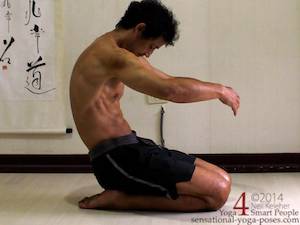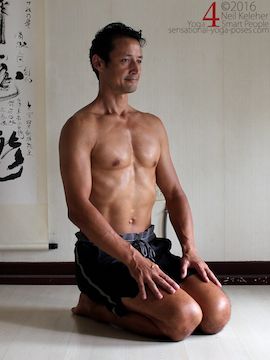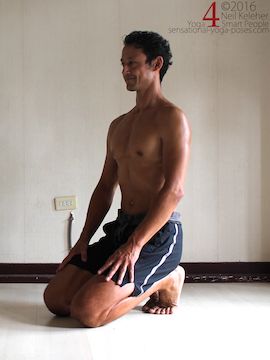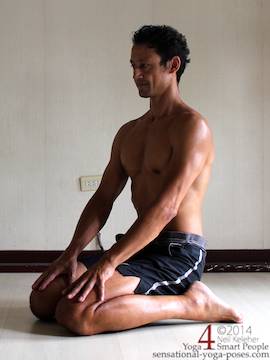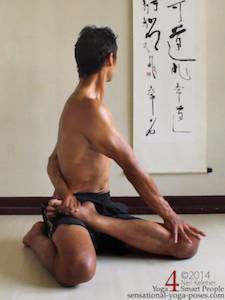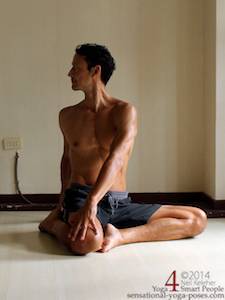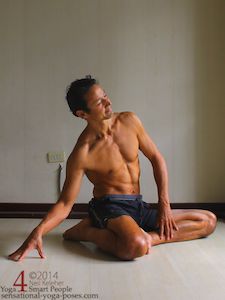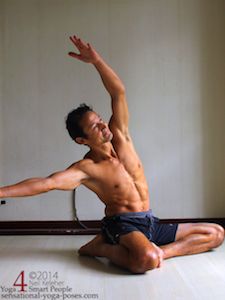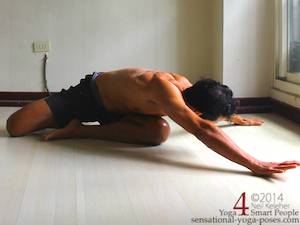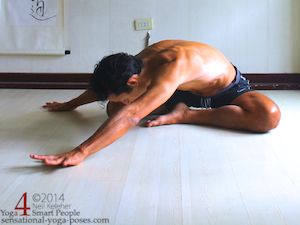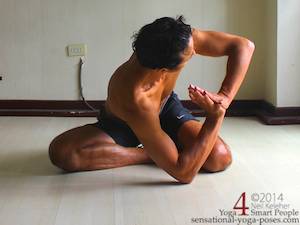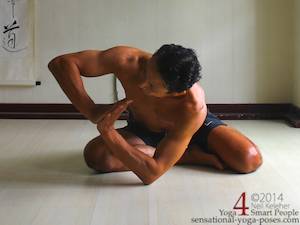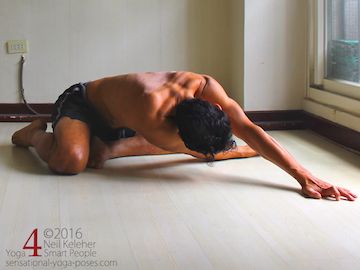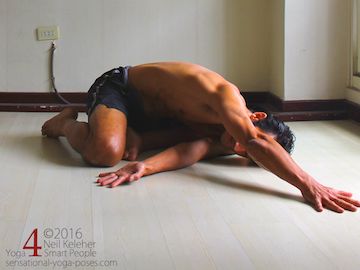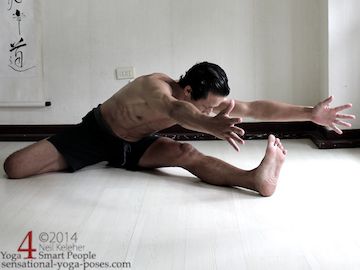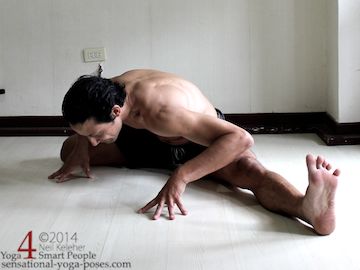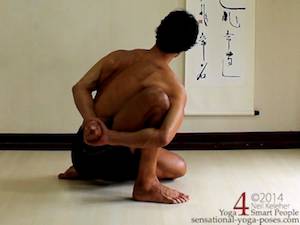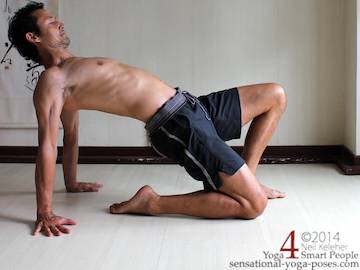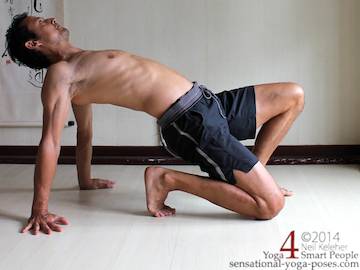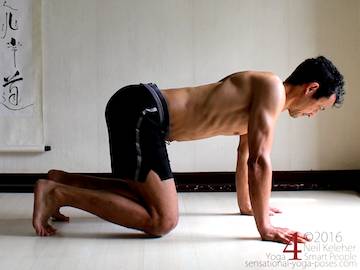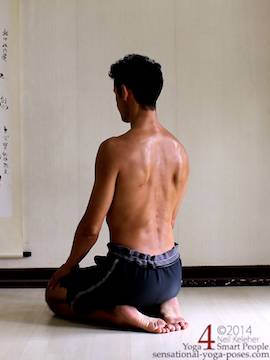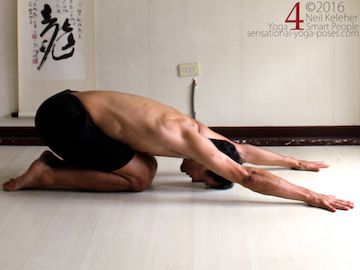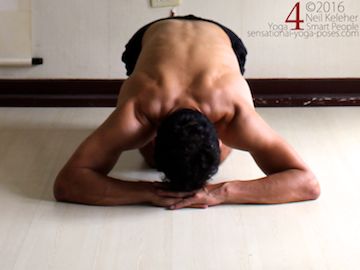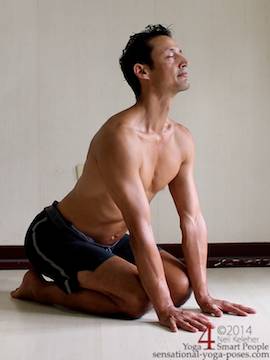Kneeling Yoga Poses
How to get comfortable with kneeling
On page cat links
Balancing on one shin, Bent back hero, Bharadvajasana, Camel pose, Child's pose, Dog pose, Forward bend seated, Half hero, Hero, Hip flexor stretch, Knee balance, Kneeling, Marichyasana e, Quad stretch
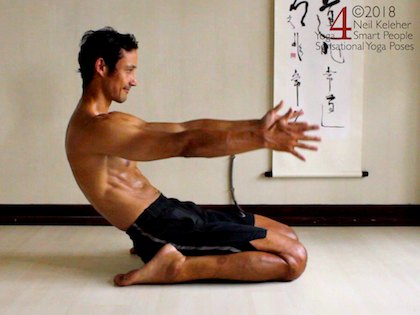
How do you get comfortable kneeling?
A simple way to get comfortable with kneeling is to activate your toes and ankles. Try pressing your toes or tops of your feet into the floor while kneeling.
How do you keep your knees safe in hero pose?
Hero pose (also known as Virasana) is a type of kneeling position where your buttocks sink to the floor between your heels.
In this kneeling yoga pose, you can help keep your knees safe by activating your toes or ankles. You can also help keep them safe by activating your quadriceps and/or hamstrings.
You could also experiment with activating your calf muscles.
A variation of hero pose is to kneel with one knee with the other knee straight. From here you can remain upright, bend forwards or gradually recline backwards. Working towards the reclining version is described here: reclining half hero
Kneeling poses index
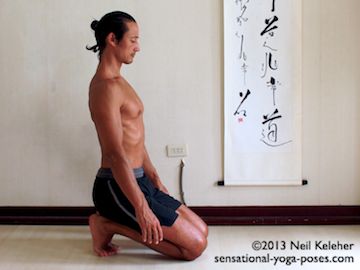
Kneeling w/ toes tucked
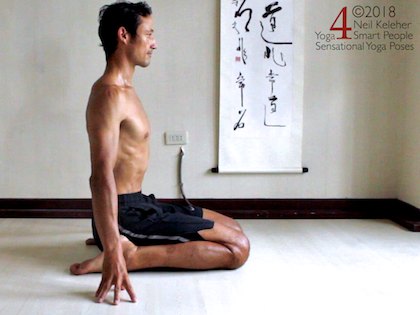
Hero pose
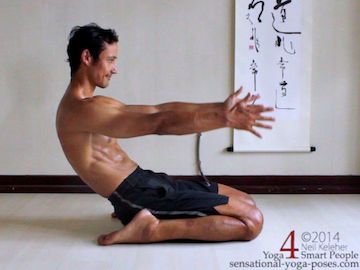
Bent back hero pose
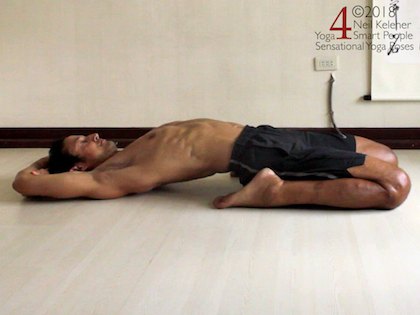
Reclining hero pose
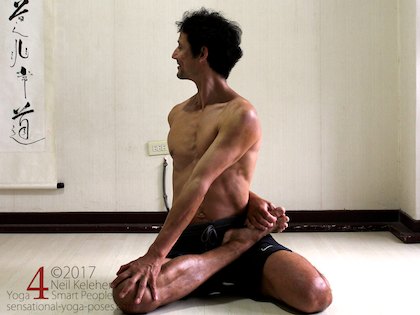
Bharad-vajasana
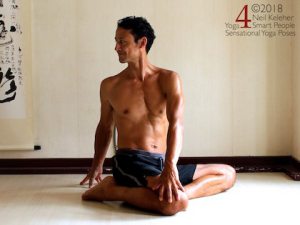
Mod. bharad-vajasana
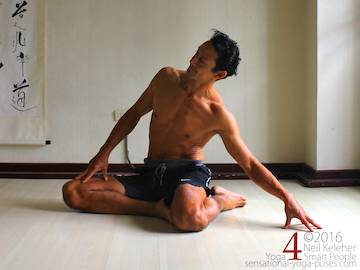
Options
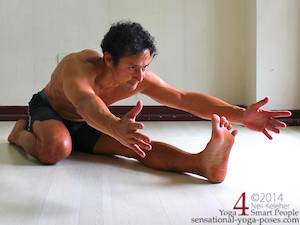
Half hero forward bend
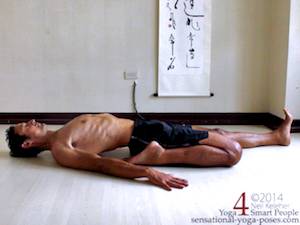
Reclining half hero
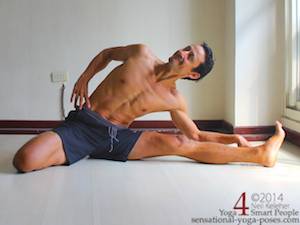
Half hero side bend
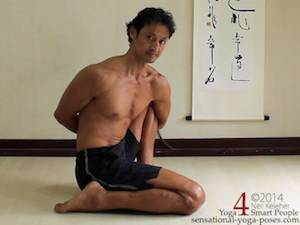
Marichyasana E
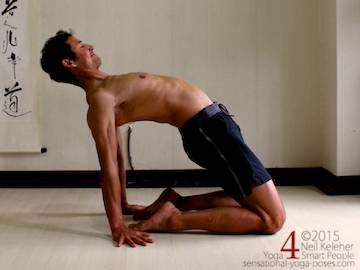
Camel pose
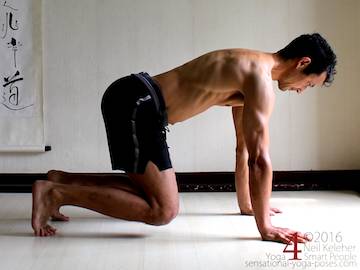
Dog pose (lifted knee cat pose)
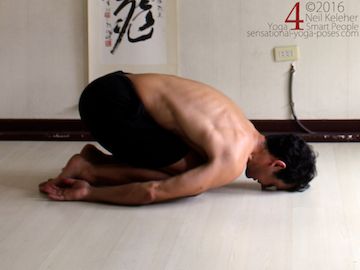
Child's pose
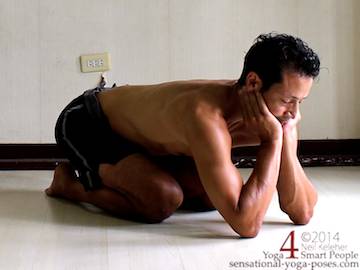
Child's pose variant
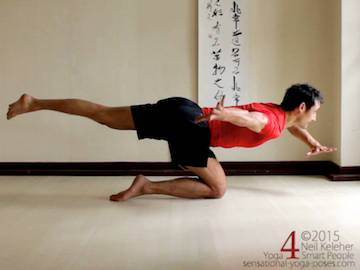
Shin balance
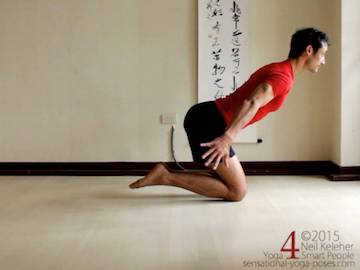
Knee balance
If you have difficulty with kneeling yoga poses and you either have tight ankles or knees that have difficulty bending completely then may find it easier to work towards kneeling by starting with ankle stretches.
Work at either pressing your toes into the floor, or at curling your toes off of the floor so that the muscles of your feet become active. You may find it easier both to stretch your ankles and to work towards either a full kneeling position or even hero pose.
For all kneeling positions pay attention to your knees, hip and ankles.
Adjust their position when necessary and come out if the tendons and ligaments feel out of place.
Be cautious. If your knee feels uncomfortable, smoothly come out and adjust your foot and knee position, or shake the knee back out. Rest from these type of positions anytime you don't feel up to it.
Note that you may choose to work towards upright kneeling with the feet turned out (so that the inner edges of the feet are on the floor).
This externally rotates the shin with respect to the thigh. Work towards this gradually and carefully if you do choose to do so.
For hero pose variations (with the foot outside the hip) you may choose to counterpose with some sort of foot action where the shin is internally rotated relative to the thigh. An example of this is janu sirsasana C and half lotus pose.
Below are two kneeling poses with pelvis tilted backwards and the spine bent forwards.
- In the first the buttocks are on top of the heels.
- In the second the feet are separated so that the buttocks are touching floor between the feet.
Poses with the latter foot position are known as hero pose.
Kneeling with feet flat on the floor could be considered a stretch for the front of the ankles.
Kneeling with toes tucked under can be used to stretch the bottom of the toes and feet.
To make this latter kneeling yoga pose more comfortable, try pressing your toes down into the floor.
To work towards hero pose (virasana) you can first separate your feet and place a yoga block between them and sit on the block (not shown).
Try actively resisting the stretch. Press your toes into the floor and press your shins down as if trying to lift your pelvis. Then slowly relax. Repeat a few times (x5 or more) and then come out of it.
Once your knees are used to this position you can try removing the block and letting your hips gradually sink down. Here again you can play with resisting. Resist so that your hips lift, then slowly relax so that your hips sink down.
I'd recommend playing with the distance between your knees. Find a distance that is comfortable for both knees and hips.
To give the pose more weight, so that it is easier to sink your hips between your feet, you can tilt your pelvis backwards when working towards hero pose.
If you tilt your pelvis rearwards your lumbar spine should round or curve forwards. To carry that curve up into your thoracic spine sink your chest.
This will shift the center of gravity of your upper body slightly rearwards so that you then have more weight helping to push your hips down.
The nice thing about this method is that you can control how far back you shift your center (by varying the amount of pelvic back tilt).
After some time practicing bent back hero you may find that your buttocks touch the floor between your feet. From there you can start leaning back and working towards reclining hero pose.
Semi-kneeling postures are those where only one knee is bent.
A simple semi-kneeling yoga pose is a modified version of bharadvajasana. Usually in this pose the non-kneeling leg is in lotus pose (below left).
A modification of bharadvajasana is to place the erstwhile lotus foot against the inner thigh of the kneeling leg.
Since you can't bind the foot in this variation it's easy to twist towards the kneeling leg or away from it. If twisting towards the kneeling let you may find that you can use body weight to help sink the hip on the kneeling-leg-side. If twisting away from the kneeling leg you may find it easy to lift the hip on the kneeling-leg side. You may find that in the process you get a slight stretch along the front of the hip or thigh.
To make it easier to sink the kneeling-leg hip down, you can bend to the kneeling-leg side. Start with the hand on the floor and if your knee feels safe then slowly lift the bottom hand. To add weight to this pose (which you may find is stretching your quadriceps) you can reach first the bottom arm and then both arms to the side.
This can be used to help improve your ability to do hero pose. However, do be careful, if your knee feels uncomfortable or it feels like there's something out of place, then come out of this position and readjust your knee so that it feels right.
For knee safety, rather than suddenly bending to the side, and suddenly lifting your arms, do all actions slowly and smoothly. That means coming out of the pose slowly too. Stop when you need to.
Other options using this semi-kneeling leg position include bending forwards and either twisting or sidebending the spine (or just bending forwards.)
You could also use this as an opportunity to stretch the back of your shoulders one-at-a-time. (Try either option shown below to see which one works best for you.)
Another semi-kneeling leg position is to have the non-kneeling leg straight. Yoga kneeling posture options for kneeling with one knee bent and the other leg straight include bending forwards and laying backwards. The first position is called triang muka eka pada paschimottanasana and is used in the Ashtanga Yoga Poses Primary series.
When bending forwards, so that you can easily lift both hands, focus on pressing the straight leg down, into the floor.
The second position with one leg straight and the other in hero could be called Reclining Half Hero Yoga Pose and can be used as the first in a series of reclining hip flexor and quadriceps stretches.
As the name implies, you lie back in this semi-kneeling yoga pose to stretch the quadriceps of the bent knee leg.
Semi-kneeling with the thighs open 90 degrees in Hurdlers stretch, you can bend to the side to stretch the side of the body, or bend forwards over the straight leg to stretch the hamstrings, or bend forwards between the thighs to stretch the hip and inner thigh of the bent-knee leg.
Another semi-kneeling yoga posture is this marichyasana yoga posture variation. I use it because it can be easier to bind in this position.
For camel pose you can start in a seated kneeling position with your hands on the floor behind you. From there push your hips forwards and up while keeping your hands on the floor. Alternatively place your hands on your heels with feet flat on the floor or with toes tucked under.
An alternate entry is to start in an upright kneeling position. Press your hips forwards and at the same time lean your ribcage back. Attempt to place your hands on your heels or on the floor.
As you try to reach your hands down and back you'll probably find that you want to move your pelvis back also. To pull your hips forwards you could focus on using your quadriceps as if to straighten the knees. Because the shins are on the floor the effect will be to pull forwards on the thigh bones, bringing the pelvis and the rest of the upper body with them.
Another alternative is to focus on using the gluteus maximus and the muscles at the backs of the thighs. Because the knees are bent it may be difficult to recruit the hamstrings. So try the adductor-magnus-long-head instead. In either case try to activate your butt and the back of your thighs so that your thighs and pelvis move forwards.
You can also try this pose one leg at a time, both with toes tucked under or top of the foor flat on the floor. Try to use the non-kneeling leg to help pull your pelvis forwards and upwards.
Since camel pose stretches the front of the hips (and spine) a kneeling counterpose that can be used to strengthen the front of the hips and abs is "dog pose" knee lift. Kneeling with your hands on the floor in front of you, press your feet into the floor and then lift your knees an inch off of the floor. For this pose do use your quadriceps to help lift your knees. In addition, round your back and spread your shoulder blades.
Kneeling could be used as a rest position (below).
I like to rest while kneeling upright, but in a kneeling pose called child's pose you bend forwards and rest your forehead on the floor. I generally find this more comfortable with the arms back as opposed to forwards. Optionally you can rest your forehead on the backs of your hands.
Some other kneeling yoga pose variations with the torso forwards include these cobra yoga pose variations found in the yoga postures for back pain series.
For a change of pace, you can also practice balance while kneeling.
Published: 2015 04 20
Updated: 2021 01 24


















